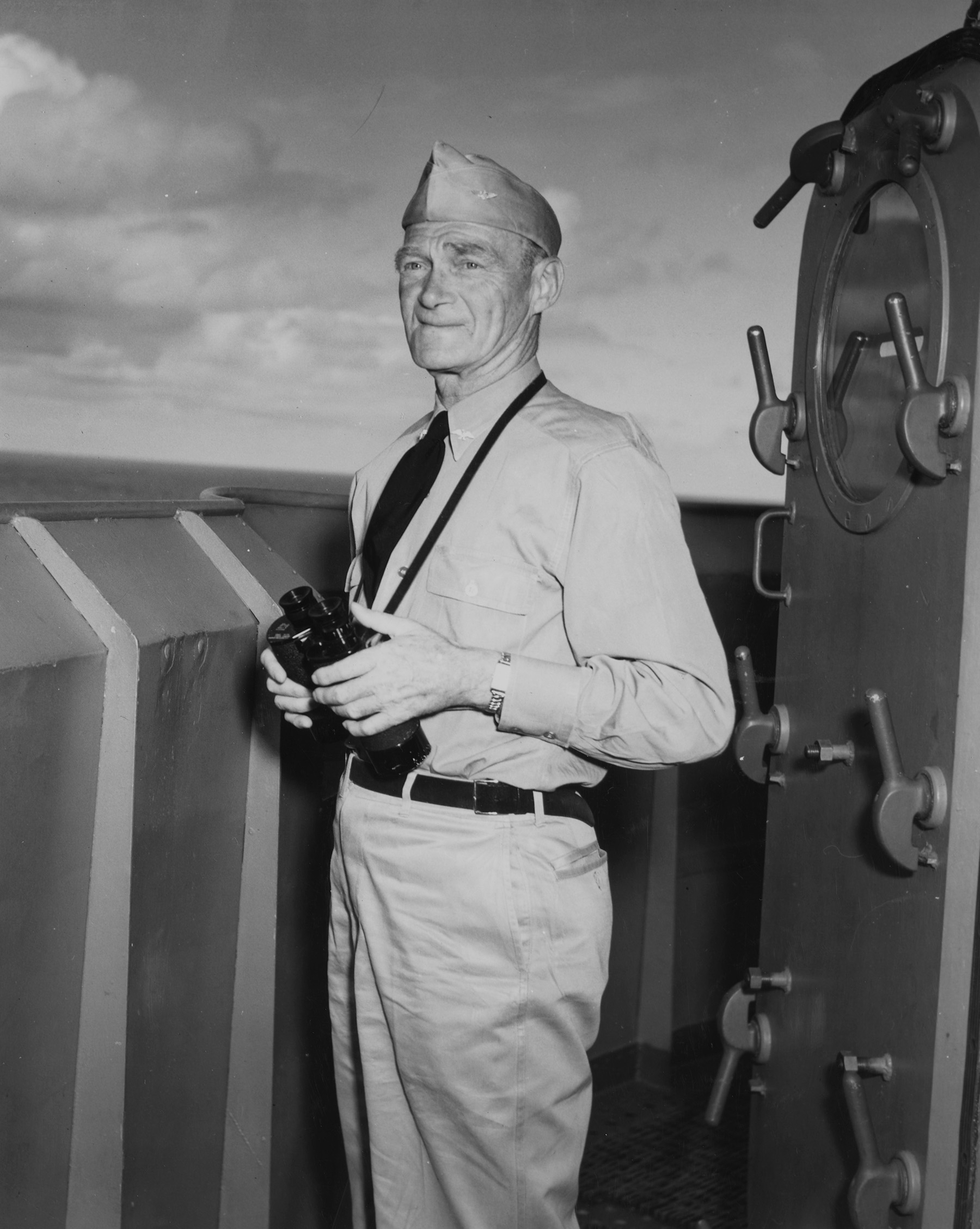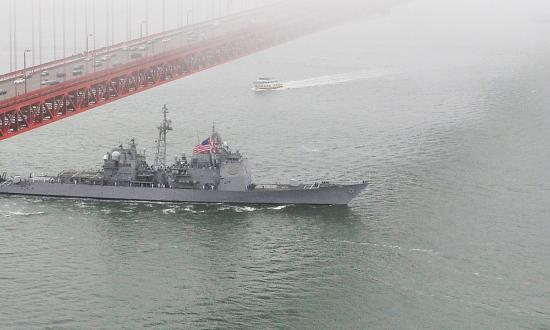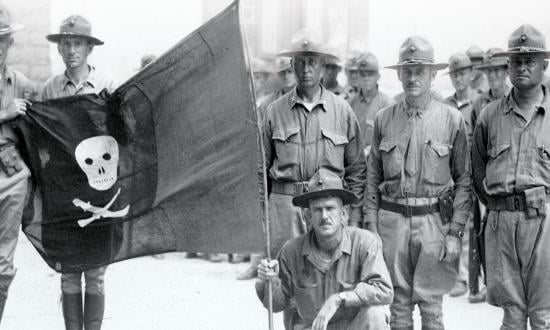Bruce Greer, U.S. Navy Veteran
President John Adams. He played a key role in founding the Navy and in establishing the force in the War of 1812. Naming CVN-82 for him would continue the tradition of most of the Nimitz class to name carriers for Presidents with a strong naval background.
Doug Sjoberg, U.S. Navy Veteran
Richard Halsey Best, honoring Lieutenant Dick Best, commanding officer of Bombing Squadron Six at the Battle of Midway. Best’s heroics led to the sinking of two enemy carriers. His example is the reason a carrier exists—to get a pilot and his plane to the target.
Captain John Sykes III, U.S. Army Reserve (Retired)
Benjamin Franklin, in honor of the more than 800 sailors and Marines who lost their lives in the attack on the USS Franklin (CV-13) in March 1945.
Lawrence Charters
Admiral Marc Andrew “Pete” Mitscher, one of the founders of naval aviation, who commanded the most formidable fleet the world had seen, from the Doolittle Raid through to the surrender of Japan. It is past time to name a carrier after a naval aviator.
Captain Ken Robinson, U.S. Navy (Retired)
James Bond Stockdale, in honor of the bravest of the brave Vietnam prisoners of war. While not the most senior prisoner, Stockdale assumed the foremost position of leadership for U.S. prisoners throughout the early years of the most severe torture and treatment.
Hiller B. Zobel, U.S. Navy Veteran
Eugene B. Ely, the first pilot to fly an airplane off a ship (the USS Birmingham [CS-2] in 1910) and the first to land on one (the USS Pennsylvania [ACR-4] in 1911).
Lieutenant Commander Gordon Warren, U.S. Navy (Retired)
Go back to our aviation roots and traditions. Names such as Wasp and Hornet evoke an immediate vision of aviation prowess and power projection. Names such as Lexington and Saratoga honor past sacrifice and perseverance.
James Kiracofe, U.S. Marine Corps Veteran
Ulysses S. Grant. Grant coordinated Army-Navy cooperation during the Tennessee Valley campaign and, most importantly, the siege at Vicksburg.
Lieutenant Commander Rob Schmidt, U.S. Navy (Retired)
The United States. It was one of the original six U.S. Navy frigates and was supposed to be a post–World War I battle cruiser, a post–World War II aircraft carrier, and a Nimitz-class aircraft carrier. The first two were canceled and the third was renamed. It is about time.
Chief Petty Officer Kenneth W. Ackley, U.S. Navy (Retired)
As the location of the first flight of a heavier-than-air aircraft, Kitty Hawk would be an appropriate name for CVN-82.
Lieutenant Colonel Marshall Snyder, U.S. Marine Corps (Retired), Life Member
Marine Corps General Roy Geiger. He enlisted in 1907 and was commissioned in 1909. He became naval aviator #49 in 1917. He commanded a Marine bombing squadron in 1918, the Cactus Air Force on Guadalcanal, and III Amphibious Corps at Bougainville, Guam, Peleliu, and Okinawa. He also briefly commanded Tenth Army on Okinawa. Geiger was awarded two Navy Crosses.
Lieutenant Commander Thomas A. Comeau, U.S. Navy (Retired)
The next carrier should bear the name Lafayette. It would remind Americans that France is our oldest ally and should hold the title to having a “special relationship” with us. It would also strengthen our bonds with this indispensable ally and current leader of the European Union.
Lieutenant Commander Bill Hart, U.S. Navy (Retired)
CVN-82 should be named Samar to honor the men and ships of the small force that turned back a massive Japanese fleet in the Battle off Samar on 25 October 1944. More than 1,100 American sailors died and five Navy ships sank in the greatest “last stand” in U.S. naval history.
Michael R. Bertaut
Honor a real aviator’s aviator in naming CVN-82 for Captain David McCampbell, a Medal of Honor recipient and the naval aviator with the most confirmed kills in the air. Honor achievement above all, for once, and set the politics aside.
Lieutenant Colonel Laurence D. Bradley, U.S. Marine Corps Reserve (Retired)
Admiral Marc “Pete” Mitscher. He assisted in the development of naval aviation, including the first two aircraft carriers. His greatest contribution was the development of the fast carrier task force. He was captain of the USS Hornet (CV-8), which launched the Doolittle Raiders against Tokyo. He commanded Task Force 58 during World War II.
Captain Marc "Pete" Mitscher. Naval Institute Photo Archive
Captain Mark W. Davidoski, U.S. Navy Reserve (Retired)
Glenn Hammond Curtiss. Curtiss is the father of U.S. naval aviation. He invented the seaplane. Eugene Ely used a Curtiss Pusher to perform the first-ever launch and recovery from a U.S. Navy vessel. Curtiss was a gifted visionary who invented ailerons, critical for roll control in the groove!
Major Bob Cypher, U.S. Marine Corps Reserve (Retired)
The United States. These ships are too big and expensive to name after politicians. The name should carry the prestige and importance of the nation that built it.
Dennis A. Steenbergen, U.S. Navy Veteran
Phillips Haskell Bradley. Lieutenant (junior grade) Bradley was awarded many medals for bravery for his service in the Pacific during World War II, including the Navy Cross. He participated in the Battle of the Leyte Gulf and was instrumental in sinking many Japanese ships. While assigned to the USS Enterprise (CV-6) he was killed in action.
Lieutenant Colonel William Salkind, U.S. Air Force (Retired)
The next carrier should be named for James Madison. He is the father of the Constitution, which is the basis for everything we have. He was a successful wartime president. It seems like a huge oversight to not have a carrier named for him.
James Young
CVN-82 should be named either Emancipation or Suffrage (in commemoration of the nation’s ideals), or Yorktown (recognizing that storied name in Navy history and resuming naming carriers after battles). It should not be named after a political or historical figure in these troubled, partisan times.
Del Lowe, U.S. Navy Veteran
The Kansas. Why? Because that name hasn’t been used in a long time. The state has provided more to aviation than any other.
Lieutenant Commander Scott Wallace, U.S. Navy
CVN-82 should be named after Marine Corps Colonel Kenneth L. Reusser. Twice awarded the Navy Cross, he is the most decorated Marine aviator ever, having flown more than 253 combat missions and been shot down in World War II, Korea, and Vietnam.
Julia L.P. Jaworski
CVN-82 should be named for Abigail Adams, wife of founding father John Adams, who was instrumental in the birth of the U.S. Navy. Abigail was a great patriot and supported her husband’s efforts. The Navy could recognize the fact that women throughout history have supported the Navy’s mission from the halls of government to on board our country’s ships.
Chief Petty Officer John M. Duffy, U.S. Navy (Retired)
I nominate both Admiral John Towers and Admiral Joseph Reeves. Both were strong proponents of naval aviation during their service, and neither has had Navy ships named after them since the destroyer Towers and the cruiser Reeves were decommissioned. I had the honor of serving on both warships.
Midshipman Third Class Webster Lowe, U.S. Naval Academy
CVN-82 should be named after Captain David McCampbell. As a naval aviator in World War II, he was the highest-scoring ace to survive the war and once shot down nine planes in a single mission. He was awarded the Medal of Honor and Navy Cross during his career.
Commander Baron Asher, U.S. Navy (Retired)
CVN-82 should be named The McCains. Few families, short of the Sullivans, have given so much to the Navy, and to naval aviation in particular.
Patrick Bruskiewich, Royal Canadian Navy Veteran
CVN-82 should be named Layton, for Rear Admiral Edwin T. Layton. Layton was Admiral Chester Nimitz’s intelligence officer, and he played a crucial role during the Battle of Midway. He had a steady personality and a brilliant, analytic mind.
Captain Howard C. Cohen, U.S. Navy Reserve (Retired)
Given the climatic Revolutionary War Battle, the World War II roles by, first, the earlier CV-5 at Coral Sea and then the epic Battle of Midway, followed, second, by the Essex-class CV-10 (and thereafter), with the Ticonderoga-class cruiser having been decommissioned, Yorktown is fitting.
Rick True
The next Ford-class carrier should be named the USS George S. Patton. The ship’s motto can be “lead, follow, or get out of my way.” We know why he was one of the greatest generals of World War II.
Frederick Chemay, U.S. Navy Veteran
Given that Enterprise has rightfully been revived for CVN-80, continuing tribute should be paid to her World War II cohorts and their crews, who held the line against the Japanese Imperial Navy at great sacrifice in the Pacific during 1942. CVN-82 should be named either Lexington or Yorktown.
Mr. Ronald Alley Jr., Life Member
CVN-82 will be the latest, most lethal and complex warfighting machine on Earth. This “ship of state” will represent this great nation across calm and stormy seas. Her anchor will hold against enemies far and wide. Her crew will help humanity with resolve and compassion. Name her the America.
Rob Weilacher
Yorktown. We declared independence in 1776, it was won in 1781 at Yorktown. Ships bearing the name include PG-01, who greeted the Great White fleet on its return in 1908. Another, CV-5, stood with few against many in 1942, including at Midway. CV-10 earned 11 battle stars and recovered Apollo-8.
Captain Jan Maarten van Tol, U.S. Navy (Retired)
Stop the carrier naming chaos. Restore the famous battles or famous ships convention. Lexington, Saratoga, or Yorktown would be a great follow-on to Enterprise (CVN-80)! Or the USS Franklin (CV-13), one of the toughest U.S. Navy carriers ever.
Roger V. Phillips, U.S. Navy (Retired)
Our newest carrier should be named Bonhomme Richard. This would honor the past ships of that name. The second Bonhomme Richard was a carrier, and it would be great to see the moniker “Bonnie Dick” afloat once more as a humongous bird farm.
Robert Barnhouse
CVN-82 should be named Crazy Horse. The Native American chief defended his people, nation, and way of life until he died. A carrier, and all naval vessels, should do the same.
Kevin D. Wise
The next carrier should be named America. The predecessor served honorably and refused to die easily. Great follow on to the Enterprise.
Captain Steve Whitaker, U.S. Navy Reserve (Retired)
Whatever name is chosen for a new aircraft carrier, it should represent the national honor. Naming an aircraft carrier for an individual should be discontinued. The original names provide more than enough positive naval historical context to get this correct for the nation and the Navy of the future.
Einar Davison
World War II was when the U.S. Navy fought amazing life-and-death battles in the Pacific, and the one that sticks out always is Midway. Therefore, CVN-82 should be named Midway. The former USS Midway (CV-41) served for 47 years.
Steve O’Neil
It would be fitting to name the newest carrier in honor of Lieutenant Richard H. Best, commander of VB-6 at the Battle of Midway and recipient of the Navy Cross and Distinguished Flying Cross. VB-6 contributed to the sinking of the Japanese carriers Akagi and Hiryu, with Best being credited with the death blow to Akagi.
Commander Gregory Dulaney, U.S. Navy Reserve (Retired)
Name CVN-82 the Hornet. Let’s go back to our roots—no more political pandering with names.
Harry Epstein
I would call the next carrier the WF. W for all military heroes who came back wounded and F in honor of those military personnel who fell in the line of duty and never made it home. On the deck or somewhere in the ship I would have a computer terminal with all WF personnel with a little bio of their contributions to keeping our country safe. It may be a little work to get this done but look at what they gave.
Mike Farmer, U.S. Navy Veteran
Any one of these four important battles: Saratoga (winning this battle brought France into the Revolutionary War on our side); Yorktown (the final battle of the Revolutionary War); Coral Sea (he first naval battle fought with only aircraft); and Midway (the Battle of Midway was the beginning of the end of the Imperial Japanese Navy).
Joseph Catanese
Langley. Revives a name that has historical precedence and removes politics from naming.
Dave Kisor
David Cary, one of the four who died in a P-2 crash in the Antarctic on 18 October 1956 in support of what became Operation Deep Freeze at McMurdo Station.
William J. Farrell
I am weird but a staunch American and this is not a joke. I would be very proud to have the next great aircraft carrier named after James “Jimi” Marshall Hendrix, an American original artist. Laugh all you want, but give it some thought.
Bob Halsey
The next carrier should be named Saratoga, to acknowledge the importance of this Revolutionary War battle in achieving American independence and continue the legacy of service rendered by the previous two carriers with this honorable name: CV-3 (World War II) and CVA-60 (Cold War and counterterrorism actions).








